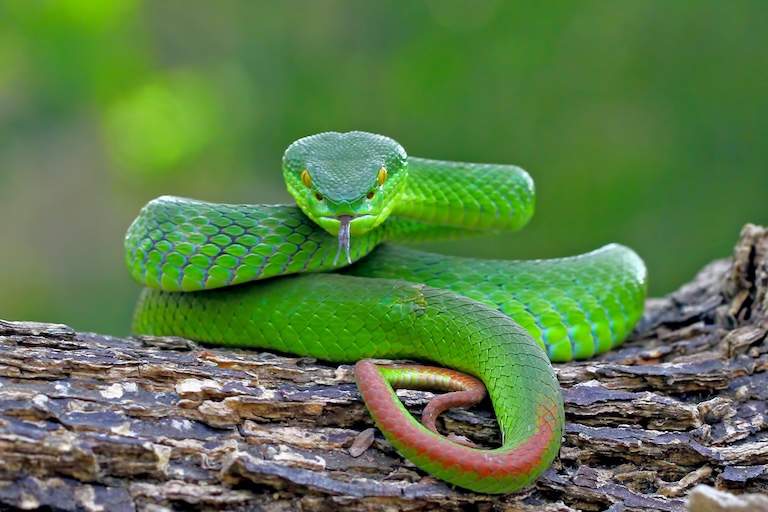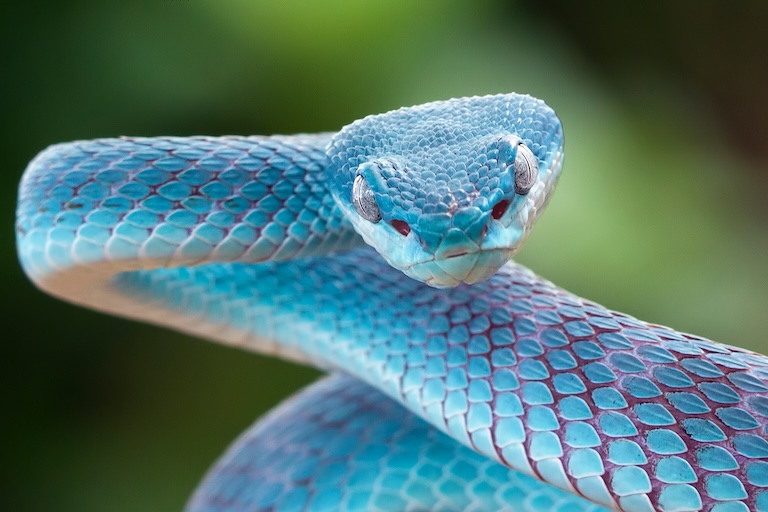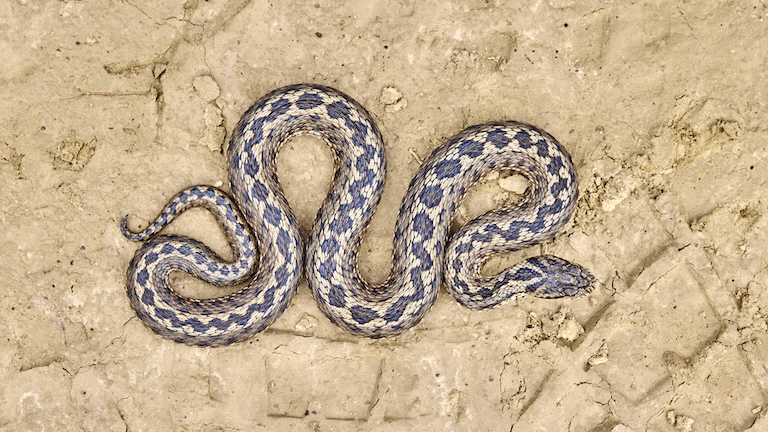Viper Profile
There are few animals as iconic as a viper, and this is reflected in just how many exciting and terrifying things are named after them.
Viper is one of the nicknames for the F-16; it’s given to one of the unsettling of all sharks: the viper dogfish; and it’s the name of that deadly yet sexy green chick from X-Men, among many others.
So, the running theme is one of the juxtaposition between beauty and lethality, and it’s hard to come up with an animal that embodies this better.

Viper Facts Overview
| Habitat: | Varied: arboreal, forest floor, savanna, desert, freshwater systems. |
| Location: | Worldwide, except polar regions, Australia, Hawaii, and similar remote islands |
| Lifespan: | 25 years + |
| Size: | Up to 2 metres in Gaboon Viper, 15cm in dwarf vipers |
| Weight: | Up to 20 kg in the largest |
| Colour: | Varied among hundreds of species, usually cryptic |
| Diet: | Usually, small mammals, also insects, and fish |
| Predators: | Raptors, some very brave mammals |
| Top Speed: | Sluggish, but with very fast striking speed |
| No. of Species: | 364+ |
| Conservation Status: | 30 species of vipers are listed as vulnerable, 33 endangered, 10 critically endangered |
Vipers are some of the most successful snakes on the planet. While, as of 2025, they have failed to colonise the oceans, they no doubt will eventually, and in the meantime, they’ve reached almost everywhere else. And they are some of the most stunning reptiles you can find alive today, coming in bright colours, subtle shades, and cryptic patterns, too.
And this last part, coupled with a healthy dose of venom, is what makes them potentially dangerous. Indeed, the snake responsible for more deaths than any other species is a viper.
But are these animals mindless killing machines, hell-bent on chasing down terrified humans, or are they an unfortunate victim of irreconcilable differences between a sit-and-wait ambush predator and a thin-skinned ape with improper footwear?
Interesting Viper Facts
1. They’re everywhere (almost)
Vipers as a family have made it all around the world, but the one thing they’re not that good at is swimming. Many species can swim – for example, the cottonmouth is also known as the water moccasin for being good in and around water – but they’re generally not as prone to it as the much more comfortable elapids.
And so, it’s the islands that have managed to avoid viper infestations, namely Ireland, Madagascar and Australia, as well as a few other places. And, of course, anywhere too cold for snakes, like Antarctica and Greenland.
But pretty much everywhere else has vipers of one flavour or another. Rainforests have them, both as arboreal species and on the ground; grasslands have them, savannas and deserts have them, and even up in the temperate drizzle, there be vipers.
In classic British blandness, the UK has the adder, which is about the least dangerous viper there is. It’s also one of the most boring to look at, yet this says more about its kin than the adder itself, which is still a very handsome animal to look at. And that’s because vipers can be truly breathtaking to look at. 1

2. They’re stunning
Starting with some of the plainest examples, the petite eyelash viper is a striking (get it?) shade of uniform yellow. Many bush vipers match this allure in reddish browns; the green tree viper does the same with emerald, and the blue pit viper can look a sort of aquamarine.
The Hairy Bush Viper is a 1970s turquoise, but there are plenty of patterned vipers, too. In fact, most come in various shades of dappled sunlight and fallen leaves, and this is one of the most significant problems for humans with this family of snakes. 2
3. They’re cryptic
Vipers rely on camouflage a lot more than most other snakes do. They often have textured skin to break up their outline, and species like the Gaboon Viper are patterned to look exactly like the drying leaves they hide amongst.
Green vipers hide in trees, brown vipers hide in dry brush, and so on. These are exceptionally well camouflaged animals, and many, like the pit vipers, scan their surroundings using the thermal imaging devices on their lips, known as “pits”.
So, vipers move very little and prefer for their food to come to them. And when it does, they strike with some of the fastest motions of any snake. 3

4. They’re muscular
Vipers are short and thick snakes, which makes them dangerous to catch. Their heads are worryingly close to their tails, and they are immensely muscular animals that can turn and strike very fast.
This burst of speed is starkly contrasted against their sluggish lifestyles, and unless striking, they are hesitant to move quickly at all.
But when they do, they really move. The Cottonmouth is the fastest-striking snake on record, able to accelerate to top speed in as little as 175 milliseconds. And even its larger cousins can whip it good.
And when they get bigger, their teeth get bigger still. 4
5. They have the longest fangs
The Gaboon viper, commonly and (with ample delusion) claimed to attack at a speed a hundred times faster than it actually can, is not the fastest snake. But it is one of the most powerful.
This enormous viper can reach up to 2 metres long, and if it gets you, it gets you good. The fangs of the gaboon viper are the longest of any snake, and they’re attached to the largest venom glands, too, so the dose of venom these bad boys can produce is also one of, if not the highest.
The gaboon viper is also the heaviest non-constrictor snake, at upwards of 20 kg in weight. But there’s more to lethality than venom injections. 5
6. They’re deadly
There are three main factors that make a snake dangerous. The first, as we just mentioned, is how much venom it injects. Many snakes give dry bites and try to save their venom for their prey. A lot of snakes don’t have any venom at all.
The second factor is the toxicity of their venom. Some snakes have stronger venom but don’t really bite, and others have weaker venom but bite a whole lot.
The third main factor is how commonly humans interact with it. And here we come to why vipers are so dangerous.
For example, most sea snakes are extremely potent animals, with the highest toxicity venoms you can find. But they’re in the sea, and people almost always are not in the sea. And to top this off, sea snakes are very hesitant to bite, and can often be handled with ease, which means their danger ranking drops off significantly.
But vipers commonly have very toxic venom, are very ready to defend themselves, and cross paths with humans by nature of both their chosen habitats and their habit of relying on camouflage to avoid danger.
Perhaps the deadliest snake on the planet is the Russel’s viper, a small snake, with medium-to-toxic venom that hides in grass in densely populated locations in India, where farmers commonly walk barefoot.
Similarly, the gaboon viper sits in dry leaves in Africa, and injects up to five times the amount of venom of the Russel’s viper. So, both of these species are high on the list of snake bite fatalities. 6

7. They’re still just snakes
This may well sound like privilege talking, when it comes from someone who grew up among the blandest of vipers, but the truth is, snakes are not the monsters they’re commonly made out to be. Alongside a plethora of other dangerous animals, these are creatures to be wary of, and to tread carefully around – literally.
But no snake considers humans food (unless it’s a desperate anaconda and the human is tiny), so making your intentions known is the key. In fact, a substantial proportion of snake bites come as a result of people trying to kill or otherwise inconvenience the snake.
And, in India, snakebite mitigation programs involving the simple solution of giving farmers torches and rubber boots radically reduced fatalities from vipers, and for almost all other families of snakes, simply banging about will let it know you’re coming and allow it to flee.
So, while vipers are beautiful, potentially deadly animals, their persecution for the latter is not the solution. In fact, they are valuable pest control that keep diseases from spreading, so by all means treat them with caution, but they should also be valued for their helpful role in our ecological communities. 7
Viper Fact-File Summary
Scientific Classification
| Kingdom: | Animalia |
| Phylum: | Chordata |
| Class: | Reptilia |
| Order: | Squamata |
| Family: | Viperidae |
| Genus: | 35 genera |
| Species Name: | 364+ species |
Fact Sources & References
- , “Adder”,The Wildlife Trusts.
- Happy Serpent, “Snake Profile: Eyelash Viper (7 Must See Pictures)”, Happy Serpent.
- , “Gaboon viper”,Science Photo Library.
- , “Gaboon Viper”,Animal Spot.
- r/natureismetal, “The Gaboon Viper has the largest fangs of all snakes ”, Reddit.
- Linda Geddes (2025), “The surprise factor that makes India’s deadliest snake even more toxic”, Vaccines Work.
- Debraj Mitra (2025), “Farmers in Hooghly get gumboots and gloves as shield against snakebites from NGO”, The Telegraph Online.
